In this blog, I’ll first share my thoughts on what kind of telescope I was looking for, and what advantages the Edge HD had to offer over other telescopes in a similar price range that convinced me to buy an 8″ Edge HD. Finally, I’ll share my “first light” experiences using the Edge HD on the moon and some of our planets.
The Edge HD offers a bigger aperture and longer focal length than APO refractors
Choosing “the right” telescope can be hard, and actually I’m convinced that there is no such thing. Each telescope has its own pros and cons. So it often comes down to looking at the best option – given the goals you have in mind. In my case, I already own a widefield apochromatic refractor – my TS 80MM F/6 Photoline APO refractor – which I use for wide(r) field astrophotography with great satisfaction. However, in order to zoom in on smaller objects such as the planets in our solar system, or some of the smaller deep-sky targets, a telescope with a bigger aperture and a longer focal length is needed. This is where refractors (lens-based telescope) get expensive for consumers. As an example, in the price range of an Edge HD, you’ll be looking at refractors that have an aperture of about 110 to 130mm, and a focal length of about 800 to 1000mm, whereas the Edge HD offers you with a whopping 200mm aperture and a 2000mm focal length. This is due to the fact that the Edge HD is a reflector (mirror-based) telescope instead of a lens-based telescope, which is cheaper to produce.
Check out the current price of the Celestron Edge HD 8″ at Agena (USA/WW), or Astroshop (EU/WW).
The Edge HD, unlike a ‘normal’ Schmidt Cassegrain telescope, produces aberration free, flat field images
The Celestron Edge HD is a smart iteration of a normal Schmidt Cassegrain design. The main goal of Celestron was to provide consumers with an affordable mirror-based telescope that has a wide aperture and focal length at a consumer-friendly price. A Schmidt-Cassegrain telescope (SCT) in its usual configuration consists of a short tube with a concave spherical primary mirror, a full-aperture corrector lens, and a smaller convex secondary mirror located on the optical axis near the center of the corrector plate. One issue with such a conventional SCT design is that the spherical mirrors lead to off-axis coma, and focal field curvature, resulting in unfocused and ‘oval’ stars at the edges of an SCTs field. This is why Celestron developed the EdgeHD. In the Edge HD design, the primary and secondary mirrors retain the smooth spherical surfaces found in a Schmidt Cassegrain telescope, and the corrector plate remains unchanged as well. However, Celestron designed the EdgeHD with two additional internal lenses placed close to the primary mirror to do the job of correcting for off-axis coma and field curvature found in a conventional SCT. The result is a flat field of sharp images without off-axis coma right out to the edge of the image. Moreover, the Starbright XLT coating ensures maximum light throughput across a wide photographic spectrum.


The Edge HD can be turned into a multi-purpose telescope with an additional 2x Barlow lens, a 0.7 reducer, or a Hyperstar
Another reason to like the Celestron Edge HD is that it can be turned into a “multi-purpose” telescope with some additional astronomy gear. The Edge HD has a native focal length of 2000mm and a 200mm (8″) aperture, so the f/ratio is 2000mm/200mm = F/10. Note that most compact SCT designs like the Edge HD have a primary mirror with a focal ratio of f/2 and a secondary with a focal ratio of f/5 yielding a system focal ratio of f/10. So let’s first assume that you want to do some planetary imaging. Most planetary imagers combine their SCTs with a 2x or 3x Barlow lens, which effectively increases your focal length to 2x2000mm= 4000mm or 3x2000mm=6000mm. At that focal length, you can easily spot surface details on planets like Jupiter or Mars, and you can get a decent picture of our inner planets, Venus and Mercury. Moreover, at this focal length, you’ll be able to spot transitions of big moons like Ganymede, Io, Europa, and Callisto in front of Jupiter, and you could make a timelapse video that shows the rotation of Jupiter and Mars.
The native F/10 ratio is a bit slow to also engage in deep-sky astrophotography. That’s why Celestron offers an optional 0.7 reducer ($409 in the USA, or €479 in Europe) that is specifically designed for the Edge HD that brings the focal ratio down to F/7. Although not superfast, F/7 is a decent F/ratio that enables you to image some of the smaller objects (nebulae, galaxies). Keep in mind that the focal length will be reduced to 1400mm. This is actually useful, as a shorter focal length is more forgiving when your mount shows some periodic errors in tracking DSOs. Note that other lens-based refractors at a similar price range have a much smaller aperture and shorter focal length. For example, big apochromatic refractors like the Explore Scientific 127mm lens-based APO refractor has an aperture of 127mm (vs 200mm with the edge HD) and a focal length of 925mm (vs. 1400mm), turning it into an F7.5 (vs. an F/7) telescope. As an alternative, you could go for a Newtonian telescope, but keep in mind that Newtonians get heavy, large, and bulky at >1000mm focal length which makes them less convenient to use, maintain, and store.
If you really want a fast telescope, you can pair your Celestron Edge HD with a hyperstar ($999 in the USA, and €1209 in Europe). Note that this is not a cheap investment, but you’ll be getting a very fast telescope. The hyperstar is placed in front of the Edge HD so that light coming from the primary mirror can be captured directly with your camera. The primary mirror is F/2, so the hyperstar effectively turns your telescope into an 200mm aperture by 400mm focal length telescope. Now, as an alternative, you could ofcourse buy a much cheaper lens-based apochromatic refractor or Newtonian telescope. However, keep in mind that that a refractor will have an aperture of about 80mm (vs 200mm) and an F/ratio of about F/6 (vs F/2). Alternatively, the Newtonian refractor will have a similar aperture (200mm) but an F/ratio of – at minimum – F/4. So although the hyperstar system is far from cheap, you will have the advantage of owning one of the fastest widefield telescopes on the astrophotography market today, similar to the 8″ Celestron RASA ($2079 in the USA and €2249 in Europe) telescopes that are actually based on this design.
The Celestron Edge HD is light-weight and compact in comparison to other mirror-based telescopes
At 6.3kg (14 lbs) and 432mm (17″) tube length, the Edge HD 8″ is a lightweight, compact telescope which makes it easy to handle. The telescope is light and small enough to carry outside and connect to your mount without breaking your back in the process. In comparison, the average 8″ F/5 Newtonian (or Dobsonian) telescopes are generally larger, heavier, and bulkier. For me, this is a big pro, also because I do not have tons of storage space as I live with my family in a small house in the city center. Moreover, collimation should be relatively easy as the Edge HD design has spherical mirrors instead of parabolic mirrors like in Richey Cretien telescopes, which do make collimation more complex.
First experiences: Unboxing and setting up the Celestron Edge HD
The 8″ Edge HD comes with a finderscope, a bracket to mount the finderscope on your Edge HD, a 1.25-inch star diagonal, and a 40mm eyepiece. I will probably never use the star diagonal and eyepiece as I’ll use it exclusively for planetary imaging and deep-sky astrophotography. Mounting the finderscope is useful, as you are going to be working with a 2000mm focal length. By aligning your finderscope with the field of view of your Edge HD, it becomes much easier to find tiny bright objects such as our planets and get them in your field of view. Mounting the finderscope on the Edge HD is easy. Just unscrew the two left bolts at the back of your Edge HD and place the bracket for the finderscope on that spot. Then tighten the two screws again and you’re done. There are plenty of other screws you can untighten and place extra shoes or brackets for additional gear. In my case, I put an extra shoe on the back of the Edge HD to mount my Orion 50mm guide scope with my ZWO ASI 120MC camera. This finderscope is probably a bit short in focal length to guide the Celestron Edge HD, but we’ll cross that bridge another day. The Edge HD has a native SCT adapter which will accept 1.25″ adapters. So for first light, I attached my ZWO ASI1600MM pro and my ZWO ASI178MC to the native SCT adapter. I have ordered an additional SCT to 2″ adapter to mount my 2″ filter wheel and it should arrive soon. I do need my filter wheel in the city when engaging in deep-sky astrophotography because of the light pollution. As said, the Celestron Edge HD is relatively lightweight and compact, which made it easy for me to unbox it, carry it outside, and mount it on my SkyWatcher EQ6-R Pro (find my review of the EQ6R-pro here).
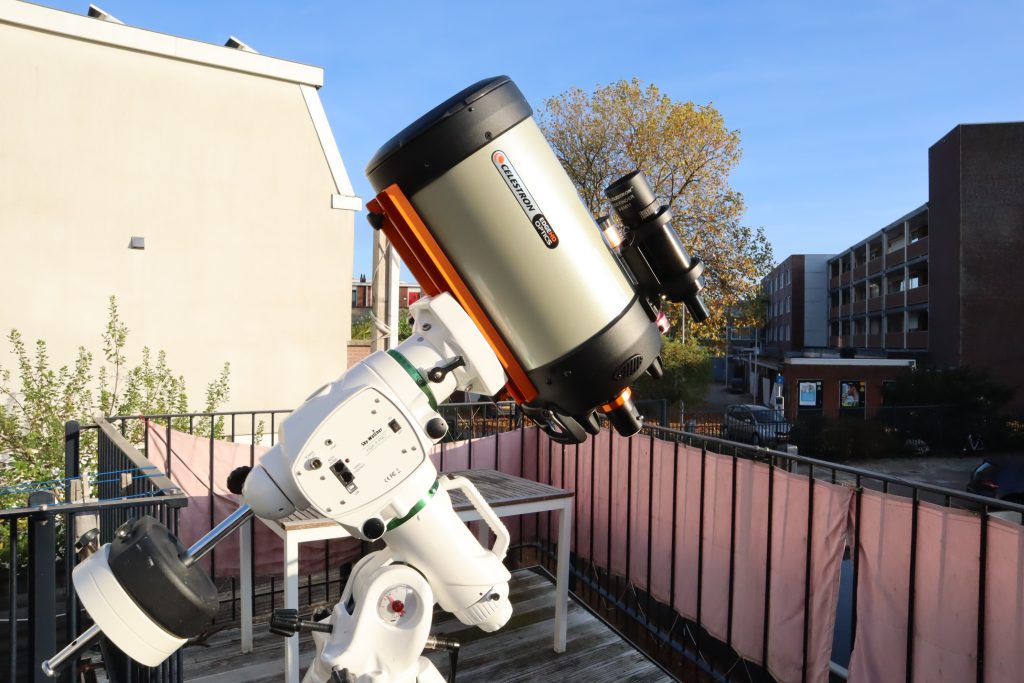

First light with the 8″ Edge HD
I first performed a daytime test with my ZWO ASI1600mm Pro attached to the 8″ Edge HD and I focussed on a tree about 500 meters away. I connected my camera via USB to my small form factor PC in my shed and I used Sharpcap to focus the camera. I was very happy to see that the Edge HD was already well collimated out of the box. The individual branches and leaves of the tree were clearly visible (in mono). I used this image to align my finderscope with the field of view I was getting in sharpcap. This was quite a different experience as compared to last summer, where I spend several nights trying to collimate a Classical Cassegrain (Richey Cretien) F/12 telescope without being completely successful. I’d like to complement Celestron for their accurate collimation procedure. This really helps the user to enjoy the telescope “out of the box” without having to spend precious time on collimating before being able to use it for the first time.
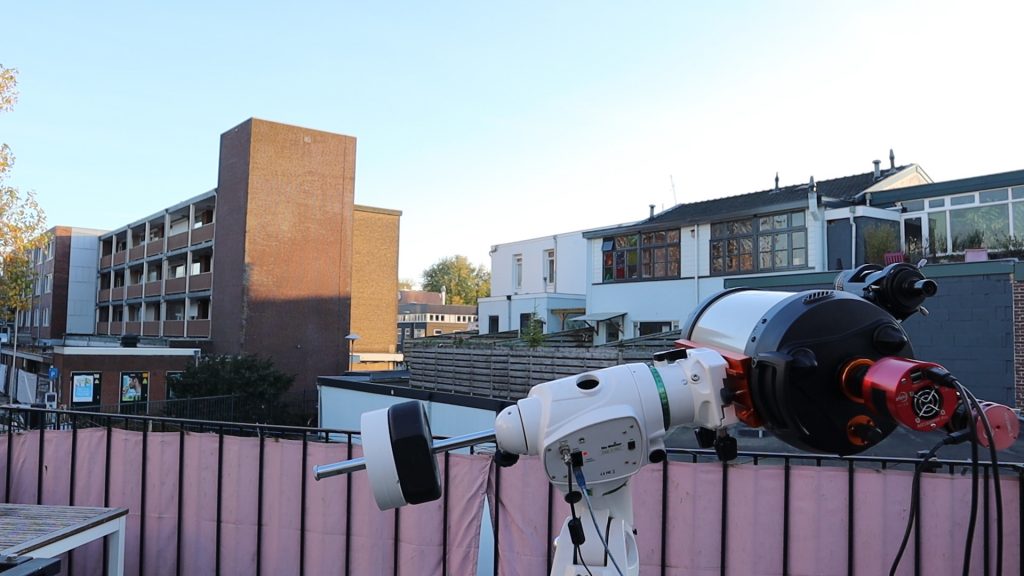

As you can see in the daytime picture, I had some high altitude clouds hanging over my city. These clouds were also present during the night, and the turbulence was quite high. Nevertheless, I was excited to see what kind of images I could get, even under these poor seeing conditions, so I went ahead and started my first imaging session with the Celestron 8″ Edge HD. I first tried to polar align the mount using the sharpcap collimation procedure. I was very happy to see sharp stars that sharpcap could recognize – polar aligning my telescope using the sharp cap procedure took about 5 minutes. After polar alignment, I focused on the waning moon which was about 65% illuminated. I used my ZWO ASI1600mm Pro at the native 2000mm focal length without adding a Barlow lens. Despite the turbulence, I got some pretty decent pictures of the Copernicus crater, the montes Apennines, the south pole, and craters on the moon, as demonstrated in the pictures below.
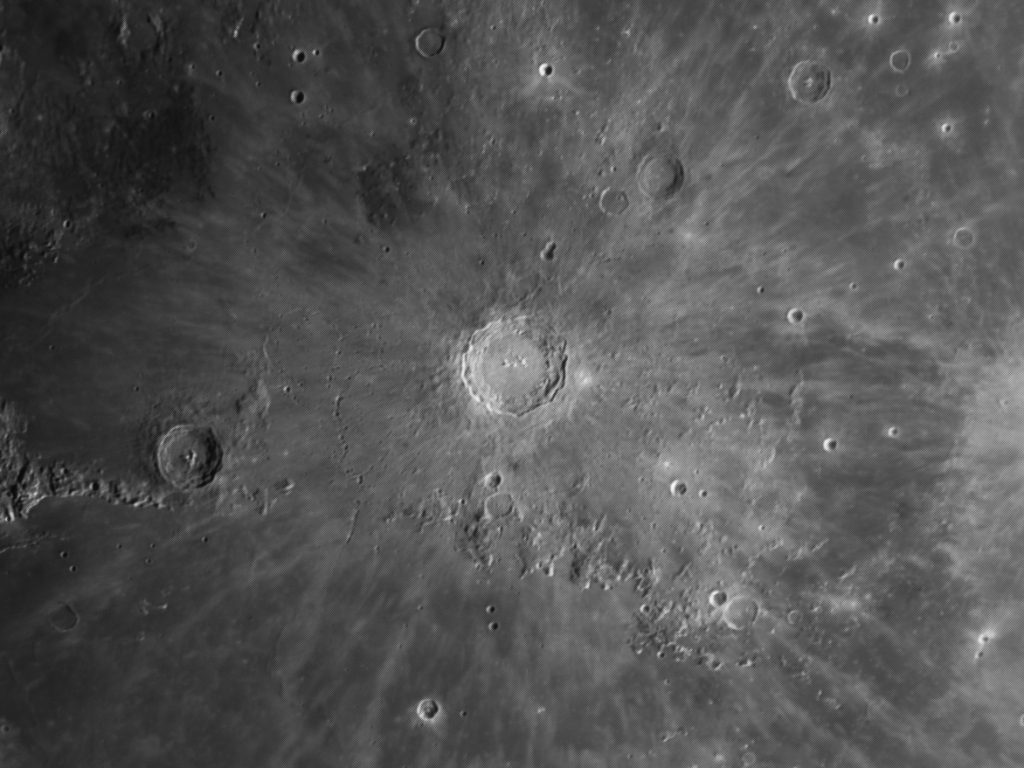
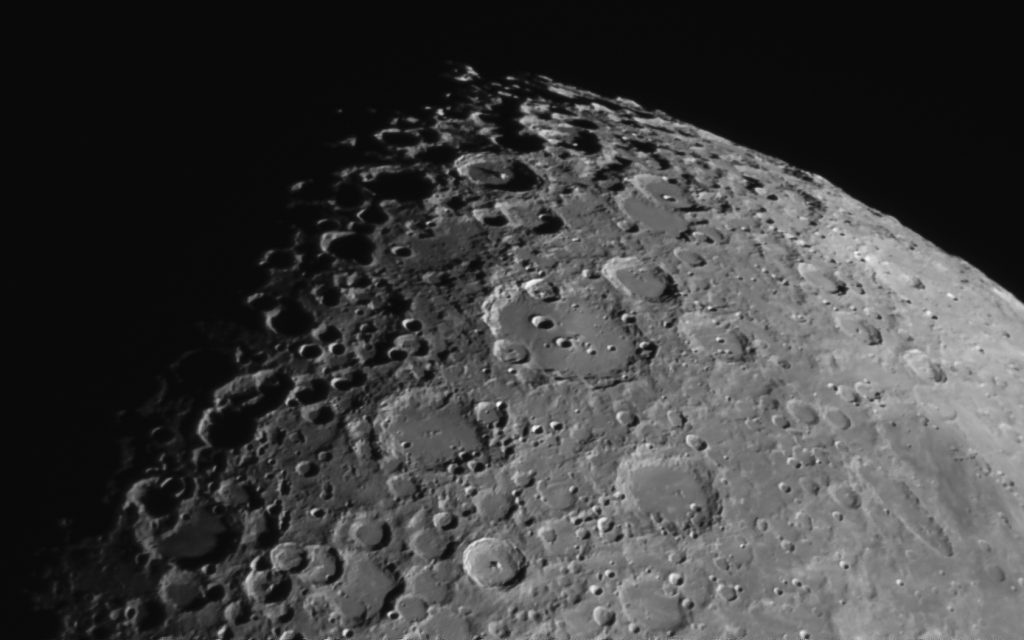
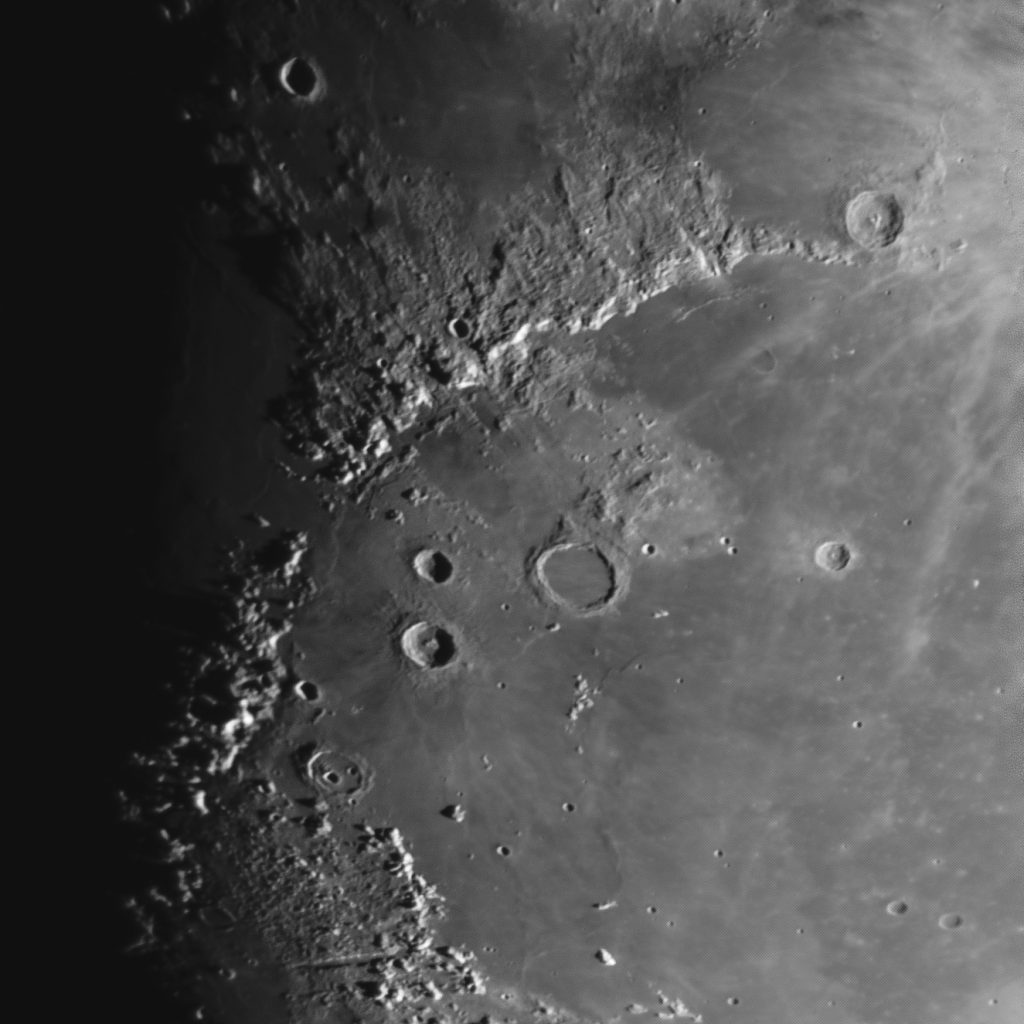

The next day, seeing conditions didn’t improve much, but I decided to try and capture some of the planets in our solar system as I was still waiting for my SCT to 2″ adapter to mount my filter wheel. Being in the second week of November 2020, I only had about 30 minutes to capture Jupiter and Saturn as my views toward the south-west are limited from my terrace in my backyard. Again, seeing conditions were poor, Jupiter and Saturn were close to the horizon and past opposition. I took my ZWO ASI178MC Cool camera and paired it with my 2.5x Barlow lens to get to a focal length of 5000mm. I only managed to take 2 short 1 minute videos without much time to focus the camera before Jupiter and Saturn were out of view. After that, I decided to focus on Mars. I was happy to find it and even see some surface details on the planet, despite the heavy turbulence and high clouds that were present.
I fell asleep on the couch (my wife didn’t like that) and woke up early in the morning at 5:00 am, only to realize that Venus is now visible as a morning star. I went back to my terrace, restarted my mount and PC, and managed to take some first videos of Venus with the 8″ Edge HD. I’m writing all this down to manage your expectations for the pictures demonstrated below. I actually think the Celestron 8″ Edge HD can do much better, given better seeing conditions and more time spent on each of the planetary targets. I processed the pictures using Autostakkert and Registax 6.
EDIT: since this blog, I’ve had far better planetary sessions. Check out my latest results with the new ZWO ASI678MC camera here, and check the tutorial section for more info on how to perform planetary imaging.
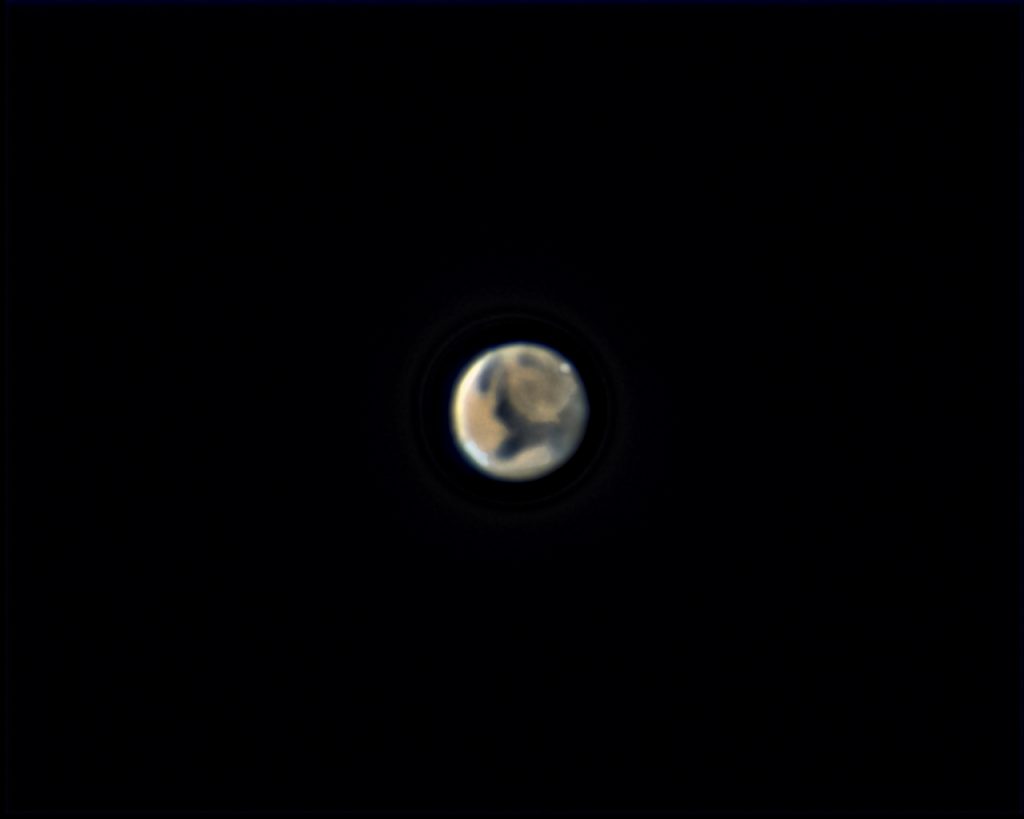

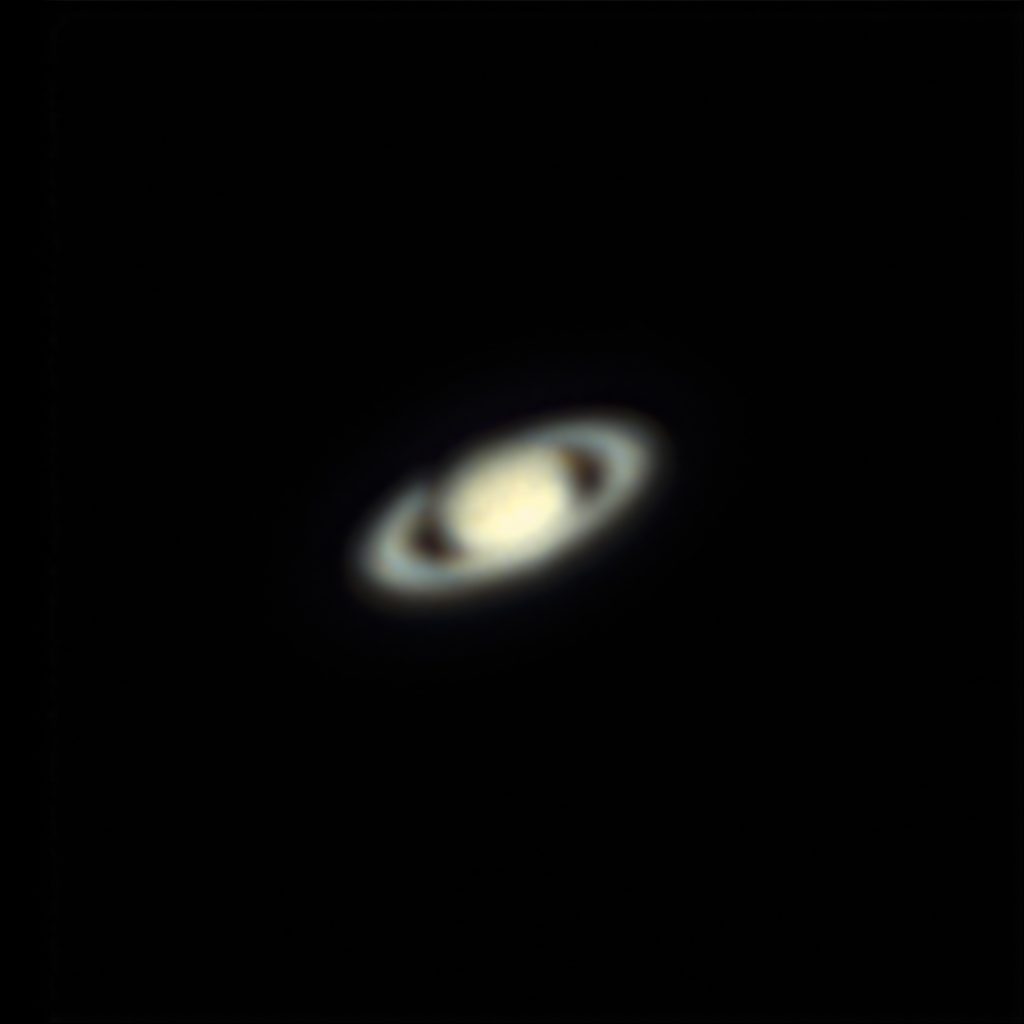
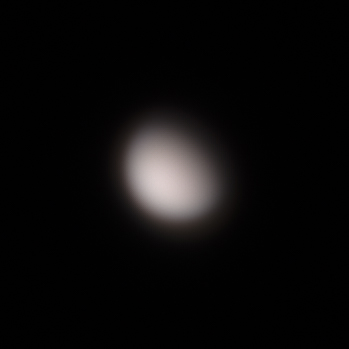
Preliminary Conclusion
My first experiences are very positive. The Celestron Edge HD 8″ is compact, lightweight, and easy to use. The telescope was readily usable out of the box for some first planetary and lunar imaging and didn’t require any additional collimation. Poor seeing prevented me from taking high-quality images of the planets, but the moon pictures show that the Edge HD is able to produce nice, crisp images of the lunar surface and I was pleased to see pinpoint stars in my live view. As seeing conditions were poor, I’ll have to wait for some decent clear skies to also test the Edge HD on some of the smaller deep sky objects. Note that you do need an additional SCT to 2″ adapter if you want to pair your 2″ filter wheel to the Edge HD. Another thing to like is that the Celestron Edge HD is very versatile with some aftermarket add-ons. You can turn the Celestron Edge HD into a superfast widefield refractor with a hyperstar, a decent, long focal length telescope for smaller deep-sky objects with a 0.7 reducer, or a nice planetary imaging telescope with an additional Barlow lens. The additional lenses of the Edge HD produce a sharp view all the way to the edge of your picture. I’ll provide updates on this telescope once I have spent more hours under the stars with it, but my first impressions are that this telescope is excellent for city dwellers like myself, who are looking for an easy to use, compact, lightweight telescope that is easy to store in-house. Also, the telescope is great for those who are dreading complex collimation or other kinds of maintenance procedures. If you are looking for a multi-purpose telescope that produces high quality pictures, is easy to handle, compact, and lightweight, look no further.
Hi Wido,
Thanks for the informative Review that preempts to answer many questions that would arise regarding the use of EDGE HD Telescopes.
I wonder if is indeed necessary to use 50 mm Filter wheel with EDGE HD 8″ ? Any reason why 36 mm Filter heel and Filters wouldn’t work with ZWO ASI1600MM Camera ?
Hi Jayant, I’m going to explore that as soon as we have come clear skies in the Netherlands.
Hey! Thanks for the great content and this write up.
I have ordered an 8” Edge HD and would like to try and get in some last chance Mars, Jupiter and Saturn.
The scope arrives next week.
I have been searching for a clear indication of what I need to connect up a suitable camera, I have a few 1.25” ZWO cameras in OSC and Mono I could use but I have no idea what should go between the scope and the camera to get the right back spacing..
I ordered a Moonlite focuser (the one that has space for the 0.7 reducer inside it) and 0.7 reducer but they won’t be here for a month yet I think.
I’ll just have the standard scope (pun intended) of supply and my guide camera. My barlow is 2” so I’m not even sure if I can use that, though it does have a 1.25” eyepiece adapter which the camera will slot into, but the 2” end I’m not sure about.
Can you offer any wisdom on what I should try to buy or use to make this work out of the box?
Thank you!
Calum
Hi Calum, sorry for the late reply. Did you resolve this? The edge HD has an SCT adapter that accepts the 1.25″ nose piece of your zwo camera. I’m still figuring out my imaging train with the reducer. Once I figure that out I’ll make a video :-).
Although I wanted this telescope primarily for planetary imaging, I realize we in the Northern hemisphere won’t have a lot to look at for a while. So, DSO imaging while I wait? What are your thoughts on Hyperstar? Will you be getting one for your Edge HD8 or will you continue using your other scope(s) for DSO photography?
Will you be getting a Hyperstar to use this for some DSO imaging or stick with your other telescope(s)?
I’m considering it Jeff, but it’s quite an investment :-). My main goal is to get the edge hd up and running with the focal reducer for galaxy season next year.
Hi Wido,
Santa Claus brought me a similar setup to yours. Can you advise the bracket / shoe that you connected your guidescope to the back of the telescope please. How are you getting on with guiding with the Orion 50mm?
Robert
I placed an order for EdgeHD 8″ + AVX bundle but I see that reviews are very mixed.
Wanted to do some planetary and DSO imaging. Refractors focal length for similar money does not seem to work for planetary.
Is DSO imaging using this bundle not going to work without, OAG and focal reducer?
My current setup is DSLR camera, Star Adventurer tracking and bunch of camera lenses including Samyang 135mm f/2
Any comment/advice appreciated.
Hi Nick, for planetary you will be fine – and yes, the edge HD will provide you with the longer focal length that refractor telescopes often lack.
I never paired my Edge HD to my Celestron AVX, it will be able to handle the payload but you may be pushing it a bit in terms of instrument capacity but I would be curious to see your results.
You would definitely need some tracking gear to guide the AVX. Doesn’t necessarily need to be an OAG, you could also try and mount a traditional smaller telescope and camera on the edge HD.
You can find an overview of the gear I’m currently using here (including my tracking gear): https://astroforumspace.com/my-astrophotography-gear/
I’m in the process of experimenting with my Edge HD myself. So far the focal length on planets is pretty good (with 2.5x barlow), and I’ve done some initial deep-sky tests with my EQ6R-pro mount and ASI1600MM pro (FoV is comparable to a DSLR).
I’m hoping that I’ll have some clear skies in the upcoming month to do a full “deep-sky project” with the Edge HD which I’ll definitely share on my channel/website.
Thanks!
Could you tell , what size guide scope do you use with your 8 HD? Was thinking about 60mm, but Trevor, of Astrobackyard says that it need to be bigger. I am so confused.
Hi Charles, Check out my latest video:https://youtu.be/OBjYIH3MQAA . I’m currently learning by doing and got decent results with my 50mm guidescope. That being said, I tend to agree with Trevor, an off axis guider or bigger guidescope is probably better. Clear skies!
Hello! I just got the Edge HD 8. I was thinking of getting the Celestron OAG. Most are back ordered. How did you connect an additional guide scope to the Edge HD? If I could figure that out I could probably get by without the OAG. Thanks!
Hi Michael, hope you’ll have a good time with your new edge HD! I bought an additional finder shoe which you can connect to the back/top right of the edge HD. Simply loosen the screws, put the finder shoe on the edge and tighten the screws. Clear skies.
Hi, Also getting the EdgeHD 8 to supplement the 80ED refractor – purely for astrophotography (also from the NL). Have you considered for one of these external focusers – eg. Moonlite -, so you can fix the primary and avoid image shift during focusing? You think it is worth the effort and significant cost? Thanks
Hi Auke, nice, have fun! I didn’t buy an automatic focuser yet. Have been getting good results by just putting the telescope in mirror lock, didn’t experience significant mirror shift. You can look at my Instagram account to check out my results. That being said, I do have to refocus between different filters and I so think about automating the focussing process.
Hi Wido,
Well done on your content. Very informative and helpful.
I have an Esprit 100 for wide field imaging but I want to try small targets such as Planetary Nebula and smaller galaxies. Maybe planets but not so much. So I am looking at my options.
If both telescopes were the same price, would you lean towards the Edge HD 8 inch or a Skywatcher Black Diamond ED150 (6 inch) with the Esprit focuser (1200mm focal length)? I have an EQ6-R mount.
I’m wondering if the benefits of a refractor might outweigh the smaller aperture and focal length?
Thanks
Hi Darren,
Thanks and good question. I think the Esprit 150 would be a nice telescope for smaller DSO’s…
For planetary imaging, you really need that longer focal length and at least an 8″ aperture in my opinion, as planets are very tiny objects in the sky.
I’ve been successful in catching smaller DSO’s with the C8 Edge HD – with an additional .7 reducer which changed my F/ratio from F/10 to F/7.
It also brings the focal length down to about 1400mm, so that would be similar to the 1200mm on the Esprit. I’ve been having a lot of fun with the Edge because of its versatility, but the 150 will undoubtedly perform nicely too.
For me, some practical stuff like the weight (only 6,3kg/14lbs) and short tube length (432mm/17″) played a role too.
Tough decision, good luck!
Hello, what’s your backfocus set? I also have EDGE HD 8, I set 105mm but still something is wrong. Could you provide one light frame from this setup as well? thank you very much
Hi there, I’m using the 105mm backfocus – as recommended by Celestron – which give me round stars. Link to the manual: https://s3.amazonaws.com/celestron-site-support-files/support_files/94242_reducer_inst_sheet.pdf
I like the idea of the 8” Edge HD with the EQ6-R. Will probably get this when I sell my Questar :-}. So… any pearls of wisdom re: focusing and tracking? OAG vs Finder scope/ camera. EAF? Thanks for your time!
Hi, I use the EQ6R Pro with a classic finder scope on top of my edge. A cheapy 50mm aperture guide scope with a 120MC, my guiding is always around .5 arc seconds per pixel.
You can buy an electronic auto focusser for the edge, e.g. celestron or ZWO EAF, I have used neither so far and I’ve saved some bucks and lost some sleep because of it. I still use EQmod for tracking with an ASCOM HEQ5/6 connection, it never fails. Hope this helps, have a nice day Jack!